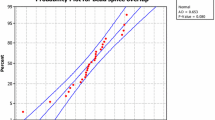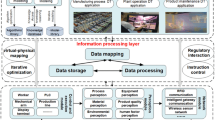Abstract
Highly iterative product development is a promising approach to continuously involve customers in development and to meet global challenges such as short product life cycles and increasing variant diversity. In this context, the planning of production technologies, which takes place in parallel to product development, faces the challenge of processing uncertain product information in early planning phases. This is due to the frequent change of the required product characteristics while the product is being developed. Technology planners must therefore adapt the effort of their planning methods to the existing information uncertainty. This paper presents a new methodology for processing uncertain information from various information sources in technology planning. Firstly, individual information are modelled using fuzzy sets. Afterwards, a new method based on the Dempster–Shafer theory of evidence is presented, which enables an aggregation of individual information from different sources considering their uncertainties. The aggregated information regarding the product characteristics are used to determine the product maturity in the current iteration loop of the highly iterative development process. Finally, the user of the methodology selects a suitable technology planning level based on the prevailing product maturity.










Similar content being viewed by others
References
Schuh G, Wetterney T, Lau F, Schröder S (2016) Next generation hardware development: framework for a tailorable development method. In: Kocaoglu DF (ed) Proceedings of PICMET’16: technology management for social innovation, Portland International Center for Management of Engineering and Technology, Honolulu, pp 2563–2572. https://doi.org/10.1109/PICMET.2016.7806807
Cooper RG, Sommer AF (2018) Agile—stage-gate for manufacturers. Res Technol Manag 61(2):17–26. https://doi.org/10.1080/08956308.2018.1421380
Goevert K, Lindner M, Lindemann U (2018) Survey on agile methods and processes in physical product development. In: ISPIM Innovation Forum, Boston, pp 1–13
Böhmer AI, Hostettler R, Richter C, Lindemann U, Conradt J, Knoll A (2017) Towards agile product development—the role of prototyping. In: Maier A et al (eds) Proceedings of the 21st international conference on engineering design (ICED 17). Design methods and tools. The Design Society, Vancouver, pp 1–10
Komus A (2014) Status Quo Agile. Success and forms of usage—hybrid and selective approaches. In: Berlin Days of Software Engineering, Berlin
Sommer AF, Hedegaard C, Dukovska-Popovska I, Steger-Jensen K (2015) Improved product development performance through agile/stage-gate hybrids. The next-generation stage-gate process? Res Technol Manag 58(1):34–45. https://doi.org/10.5437/08956308X5801236
Gartzen T, Brambring F, Basse F (2016) Target-oriented prototyping in highly iterative product development. Proced CIRP 51:19–23. https://doi.org/10.1016/j.procir.2016.05.095
Milberg J, Müller S (2007) Integrated configuration and holistic evaluation of technology chains within process planning. Prod Eng Res Dev 1(4):401–406. https://doi.org/10.1007/s11740-007-0055-3
Schuh G, Gartzen T, Basse F, Schrey E (2016) Enabling radical innovation through highly iterative product expedition in ramp up and demonstration factories. Proced CIRP 41:620–625. https://doi.org/10.1016/j.procir.2016.01.014
Klocke F, Fallböhmer M, Kopner A, Trommer G (2000) Methods and tools supporting modular process design. Robot CIM Int Manuf 16(6):411–423. https://doi.org/10.1016/S0736-5845(00)00024-7
Cooper RG (2017) Idea-to-launch gating systems. Better, faster, and more agile. Res Technol Manag 60(1):48–52. https://doi.org/10.1080/08956308.2017.1255057
Zink L, Hostetter R, Böhmer AF, Lindemann U (2017) The use of prototypes within agile product development. Explorative Case Study of a Makeathon. In: Jardim-Goncalves et al (eds) Proceedings of 2017 international conference on engineering, technology and innovation (ICE/ITMC). Madeira, pp 68–77. https://doi.org/10.1109/ICE.2017.8279871
Borsdorf R (2007) Methodische Ansatz zur Integration von Technologiewissen in den Produktentwicklungsprozess. Dissertation RWTH Aachen
Klocke F, Buchholz S, Stauder J (2014) Technology chain optimization: a systematic approach considering manufacturing history. Prod Eng Res Dev 8(5):669–678. https://doi.org/10.1007/s11740-014-0572-9
Stauder J, Buchholz S, Mattfeld P, Rey J (2016) Evaluating the substitution risk of production systems in volatile environments. Prod Eng Res Dev 10(3):305–318. https://doi.org/10.1007/s11740-016-0670-y
Cooper RG (2014) What’s next?: after stage-gate. Res Technol Manag 57(1):20–31. https://doi.org/10.5437/08956308X5606963
Schneider S (2015) Agile Prozessplanung im Produktentstehungsprozess am Beispiel der Motorenproduktion. Dissertation Technische Universität Dortmund
Klein TP (2016) Agiles Engineering im Maschinen- und Anlagenbau. Dissertation Technische Universität München
Diels F (2018) Indikatoren für die Ermittlung agil zu entwickelnder Produktumfänge. Dissertation RWTH Aachen
Salomons OW, van Houten FJAM, Kals HJJ (1993) Review of research in feature-based design. J Manuf Syst 12(2):113–132. https://doi.org/10.1016/0278-6125(93)90012-I
Klocke F, Müller J, Mattfeld P, Kukulies J, Schmitt R (2018) Integrative technology and inspection planning. A case study in medical industry. J Manuf Sci E-T ASME 140(5):1–10. https://doi.org/10.1115/1.4039114
Klocke F, Brinksmeier E, Weinert K (2005) Capability profile of hard cutting and grinding processes. CIRP Ann 54(2):22–45. https://doi.org/10.1016/S0007-8506(07)60018-3
Limbour P, Savic R, Petersen J, Kochs HD (2007) Fault tree analysis in an early design stage using the Dempster–Shafer theory of evidence. In: Aven T, Vinnem JE (eds) Risk, reliability and societal safety: proceedings of the european safety and reliability conference. Taylor & Francis, London, pp 713–722
Trommer G (2001) Methodik zur konstruktionsbegleitenden Generierung und Bewertung alternativer Fertigungsfolgen. Dissertation, RWTH Aachen
Zadeh LA (1965) Fuzzy sets. Inf Control 8(3):338–353. https://doi.org/10.1016/S0019-9958(65)90241-X
Heinsohn J, Socher-Ambrosius R (1999) Wissensverarbeitung. Eine Einführung. Spektrum Akademischer Verlag, Heidelberg
Schell H (1997) Bewertung alternativer Handhabungs- und Fertigungsfolgen. Dissertation, RWTH Aachen
Shafer G (1976) A mathematical theory of evidence. Princeton University Press, Princeton
Rebner G, Auer E, Luther W (2012) A verified realization of a Dempster–Shafer based fault tree analysis. Computing 94(2–4):313–324. https://doi.org/10.1007/s00607-011-0179-3
Boersch I (2007) Wissensverarbeitung. Spektrum Akademischer Verlag, Heidelberg
Beierle C (2014) Methoden wissensbasierter Systeme. Springer, Wiesbaden
Gordon J, Shortliffe EH (1990) The Dempster–Shafer theory of evidence. In: Pearl J, Shafer G (eds) Readings in uncertain reasoning. Morgan Kaufmann Series, San Mateo, pp 272–292
Rakowsky UK (2007) Fundamentals of the Dempster–Shafer theory and its applications to reliability modeling. Int J Reliab Qual Saf Eng 14(6):579–601. https://doi.org/10.1142/S0218539307002817
Rao PK, Kong Z, Duty CE, Smith RJ, Kunc V, Love LJ (2016) Assessment of dimensional integrity and spatial defect localization in additive manufacturing using spectral graph theory. J Manuf Sci E-T ASME 138(5):1–12. https://doi.org/10.1115/1.4031574
Feldhusen J, Grote KH (2013) Pahl/Beitz Konstruktionslehre. Methoden und Anwendung erfolgreicher Produktentwicklung. Springer, Berlin
Klocke F, Mattfeld P, Stauder J, Müller J, Grünebaum T (2017) Robust technology chain design. Considering undesired interactions within the technology chain. Prod Eng Res Dev 11(4–5):575–585. https://doi.org/10.1007/s11740-017-0756-1
Acknowledgements
The authors would like to thank the German Research Foundation DFG for the support of the depicted research within the project KL 500/211-1 “Methodology for the highly iterative design of production process sequences”.
Author information
Authors and Affiliations
Corresponding author
Rights and permissions
About this article
Cite this article
Rey, J., Apelt, S., Trauth, D. et al. Highly iterative technology planning: processing of information uncertainties in the planning of manufacturing technologies. Prod. Eng. Res. Devel. 13, 361–371 (2019). https://doi.org/10.1007/s11740-019-00882-7
Received:
Accepted:
Published:
Issue Date:
DOI: https://doi.org/10.1007/s11740-019-00882-7




